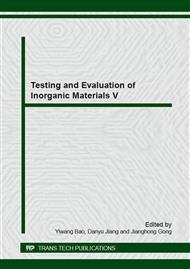p.390
p.394
p.398
p.402
p.406
p.410
p.418
p.422
p.427
Ionic Conductivity and Coordination Number of Cations in Ce1-xYxO2-x/2
Abstract:
Yttria doped ceria display higher ionic conductivity and stabilized phase which possess more advantage for solid oxide fuel cells. By using molecular dynamics simulation, the lattice parameter and oxygen conductivity of Ce1-xYxO2-x/2 (x = 0 - 0.65) at 1273 k have been investigated. Lattice parameters and ionic conductivity both increase with yttria doping while x < 0.15 but over doping of yttria lead to a decreasing trend on them. It is suggested that the closing distance of cation-anion is responsible for this decreasing. The coordination numbers of cations were also analyzed. The results showed that the vacancies prefer to locate near Y ions and vacancy ordering is independent with vacancy content.
Info:
Periodical:
Pages:
406-409
Citation:
Online since:
November 2014
Authors:
Price:
Сopyright:
© 2015 Trans Tech Publications Ltd. All Rights Reserved
Share:
Citation:


